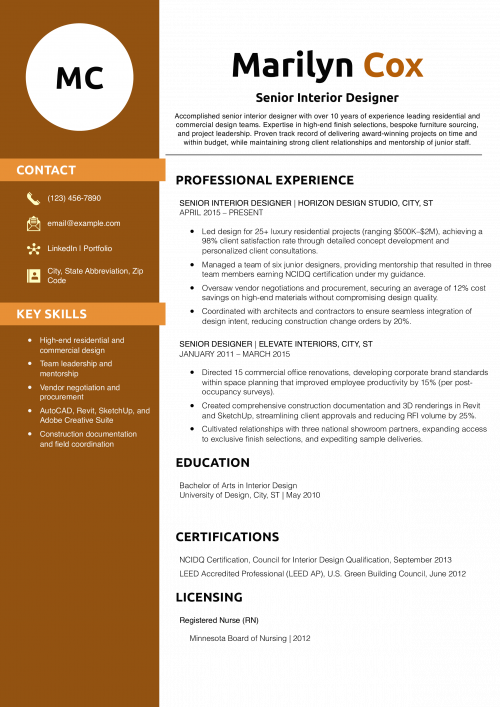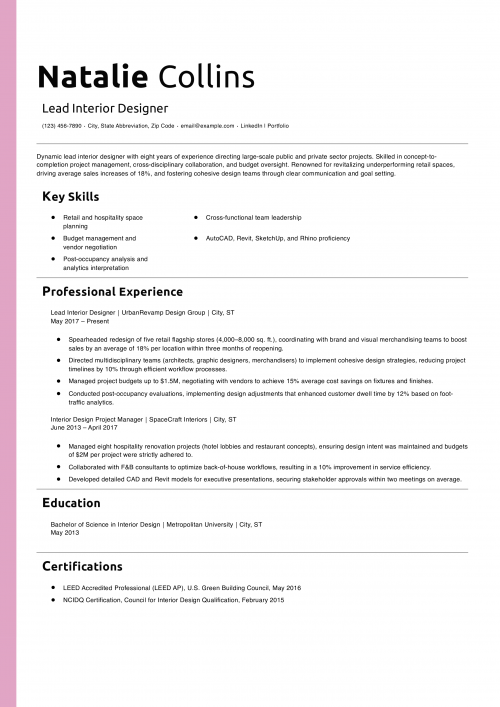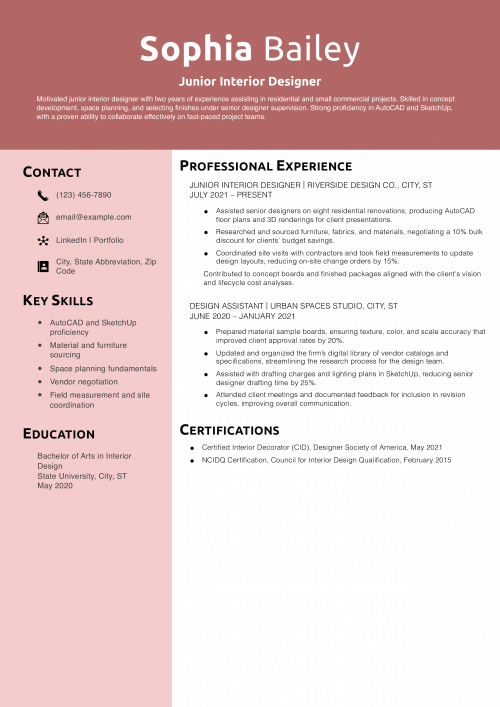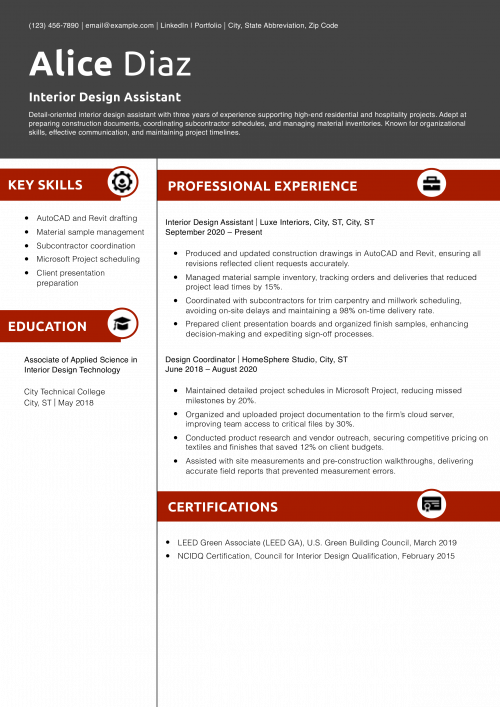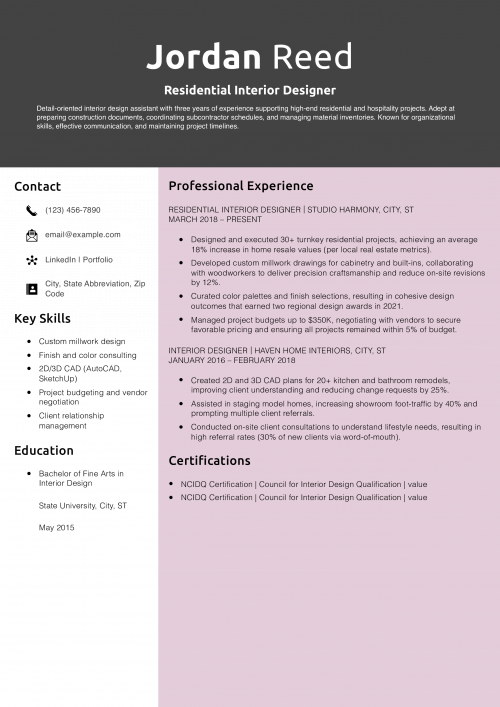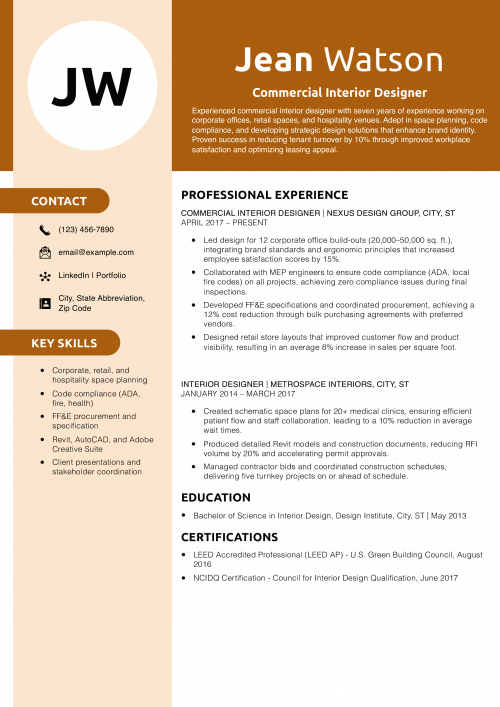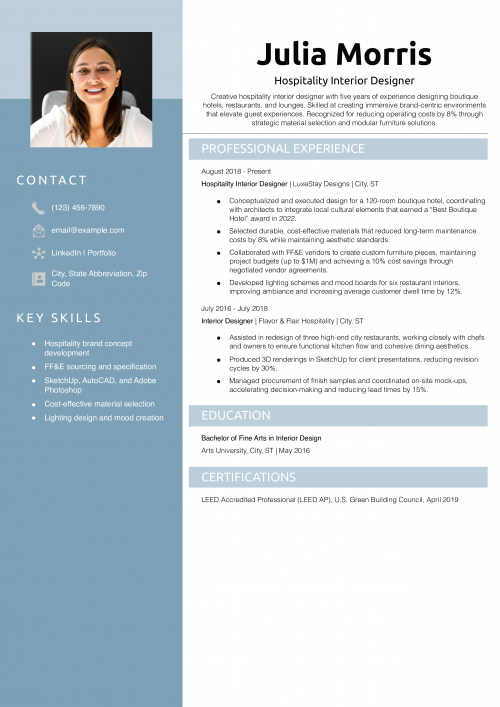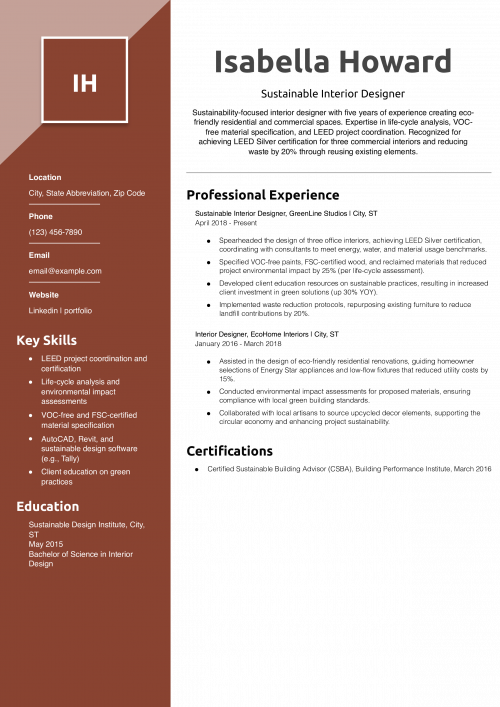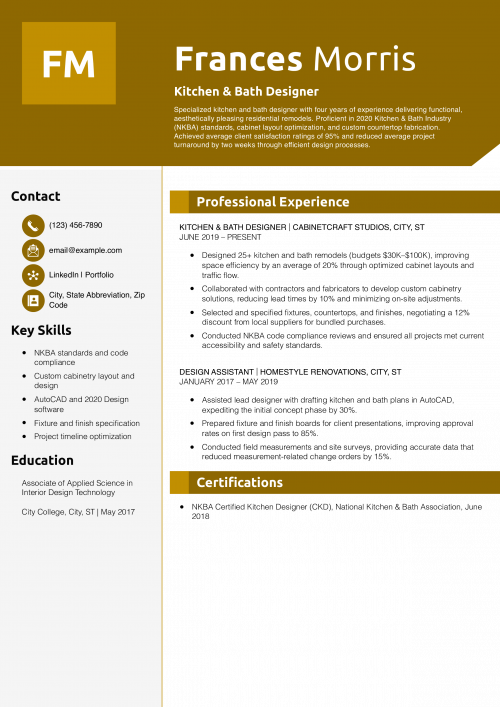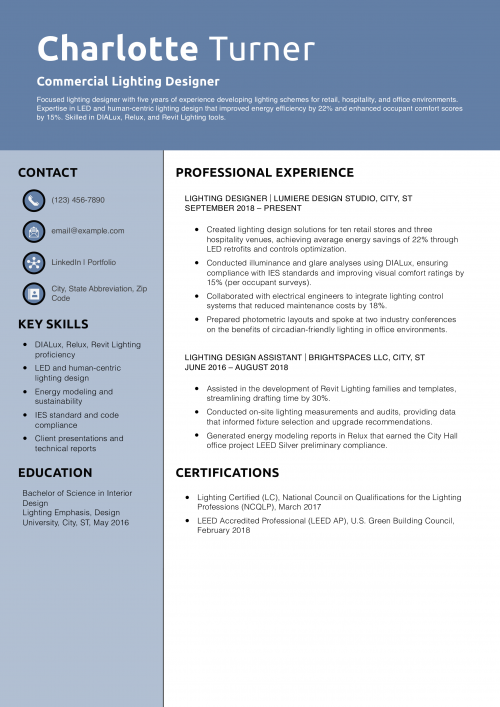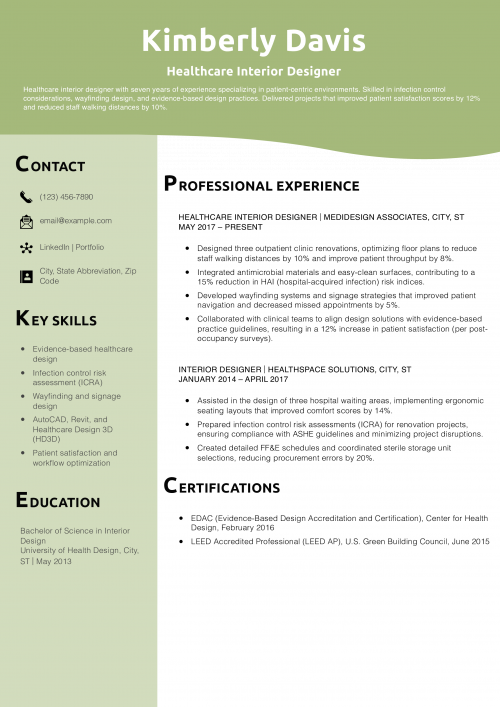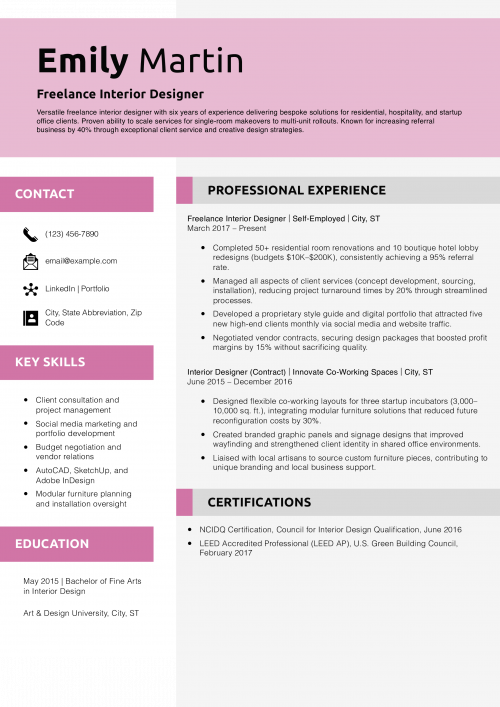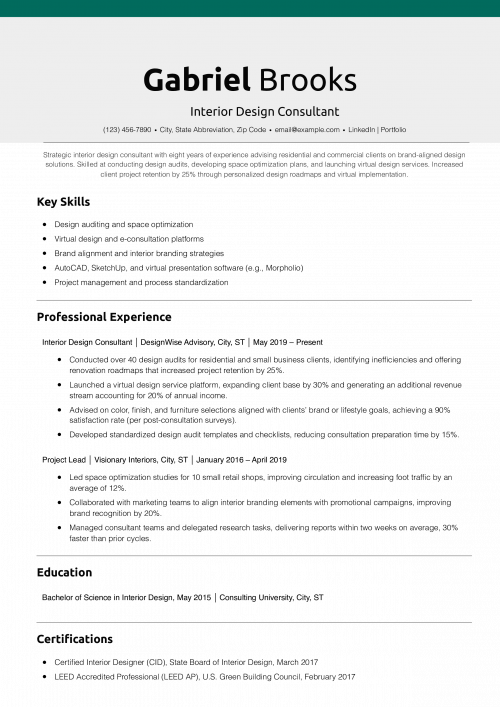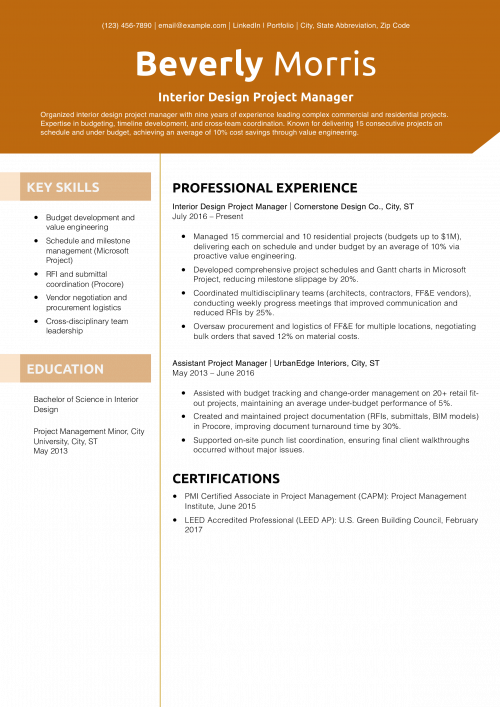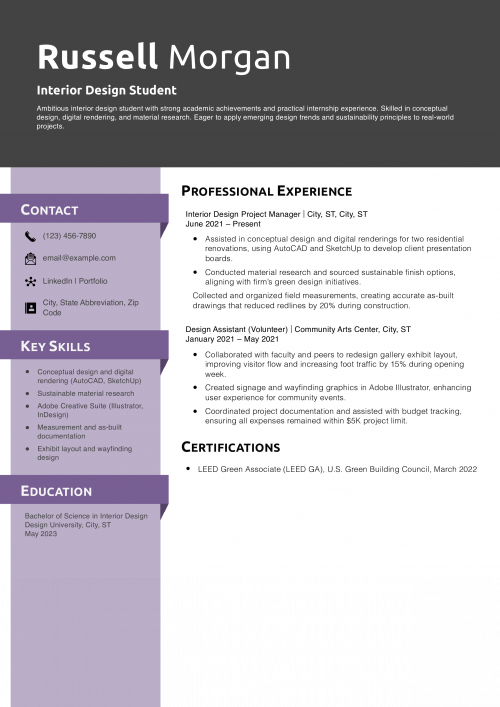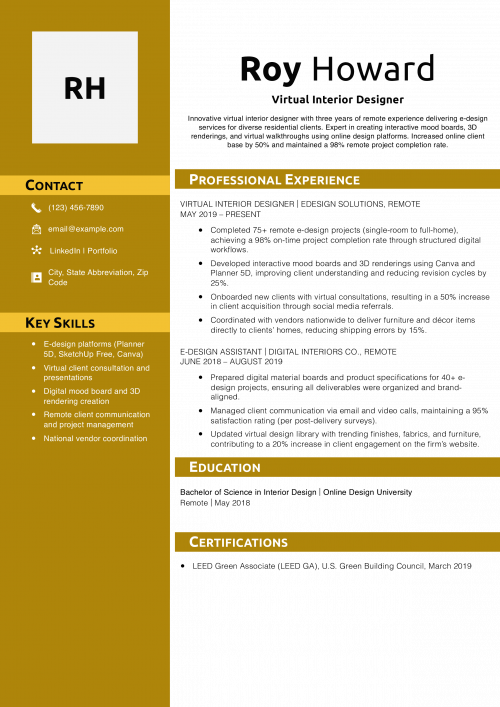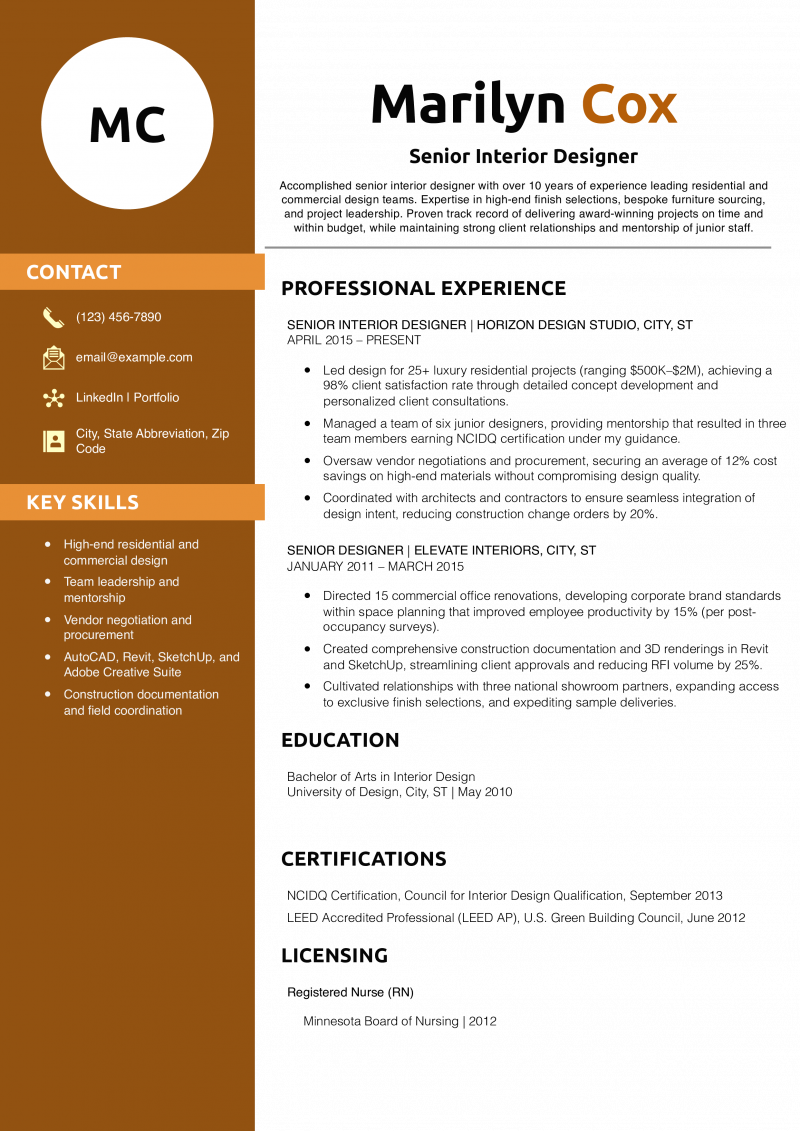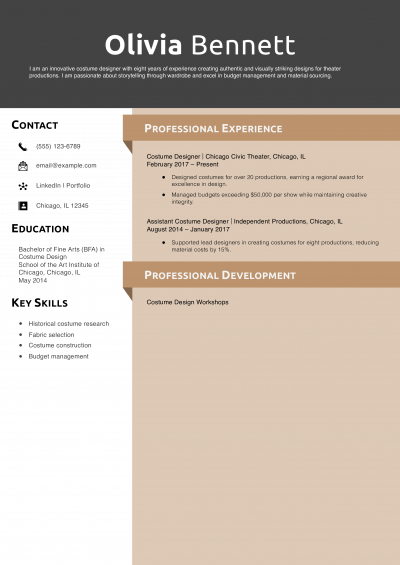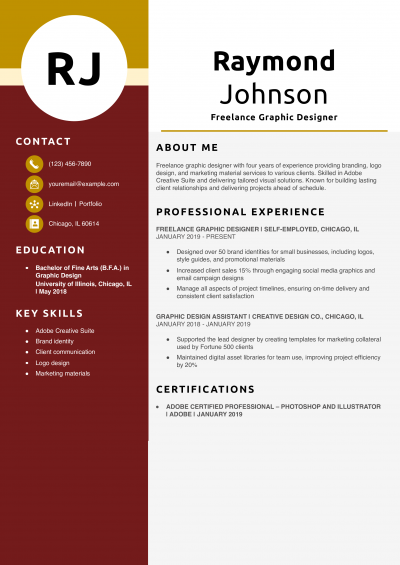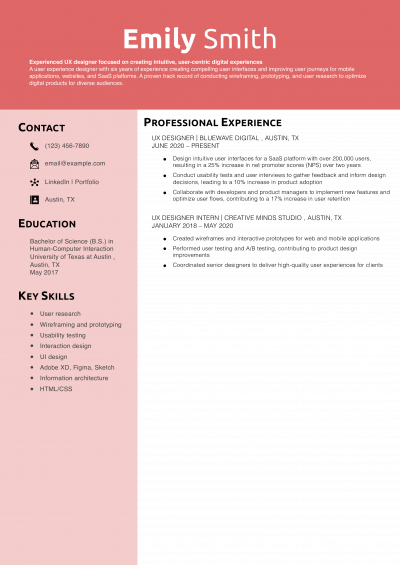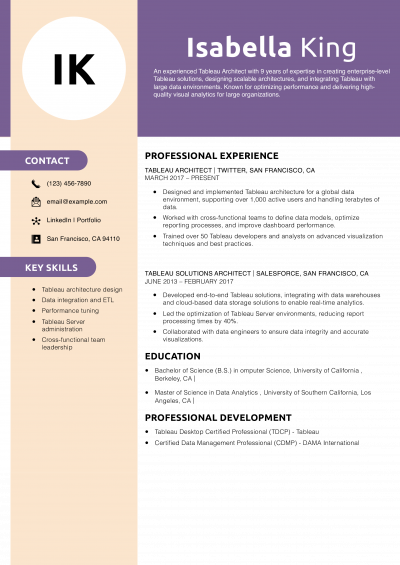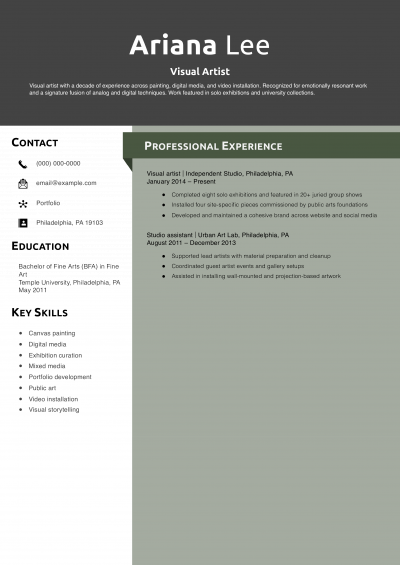Interior designers seeking new opportunities can benefit from a well-crafted resume. It should highlight your professional accomplishments, credentials, and ability to bring a client’s vision to life. From design software program expertise to space planning to client relations, your resume should spotlight why you’re a strong candidate.
Key Takeaways
- Emphasize specializations: Interior designers can specialize in different types of design, from residential to commercial spaces to certain styles and more. Your resume should include the various types of design at which you’re adept to help prospective employers see what you have to offer.
- Detail quantifiable achievements: Design-focused jobs might be subjective, but there are ways to quantify your accomplishments. Coming in under budget, having strong client ratings, or sharing the number of projects you’ve completed are all examples of things you can include in your interior design resume.
- Use keywords for ATS: Include some of the same keywords and phrases used in the job postings you’re applying for. This will help ensure that your resume is found by Applicant tracking systems (ATS) so you get to the next stage of the job search.
Most Popular Interior Design Resumes
Senior Interior Designer Resume Example

Why This Resume Is a Great Example
This resume clearly demonstrates leadership and measurable business outcomes, such as cost savings and reduced RFIs, underscoring the candidate’s ability to deliver complex projects. Highlighting mentorship achievements further emphasizes their role as a team leader.
Key Tips
Showcase your leadership impact: quantify team certifications earned under your mentorship or cost savings you negotiate. This positions you as both a creative designer and an effective manager. For more on structuring advanced experience, check out Best Resume Formats.
Lead Interior Designer Resume Example
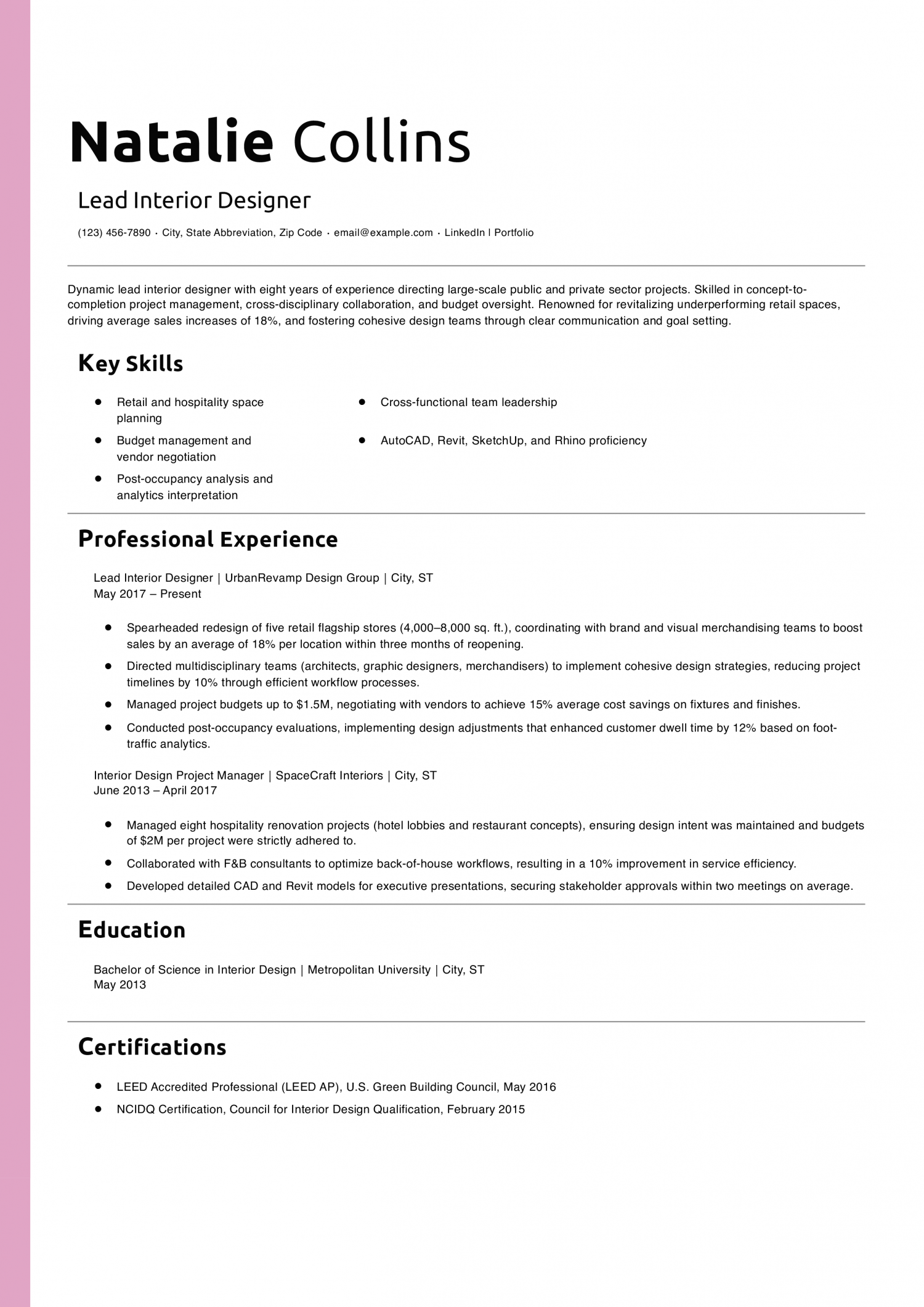
Why This Resume Is a Great Example
By quantifying revenue gains and efficiency improvements, this resume conveys how design decisions directly impact business metrics. Emphasizing cross-disciplinary leadership highlights the candidate’s ability to coordinate complex teams and deliver cohesive results.
Key Tips
Link your design work to measurable KPIs like sales increases or efficiency gains, to showcase strategic design value. For guidance on crafting results-driven summaries, see How to Write a Resume Summary.
Interior Design Coordinator Resume Example
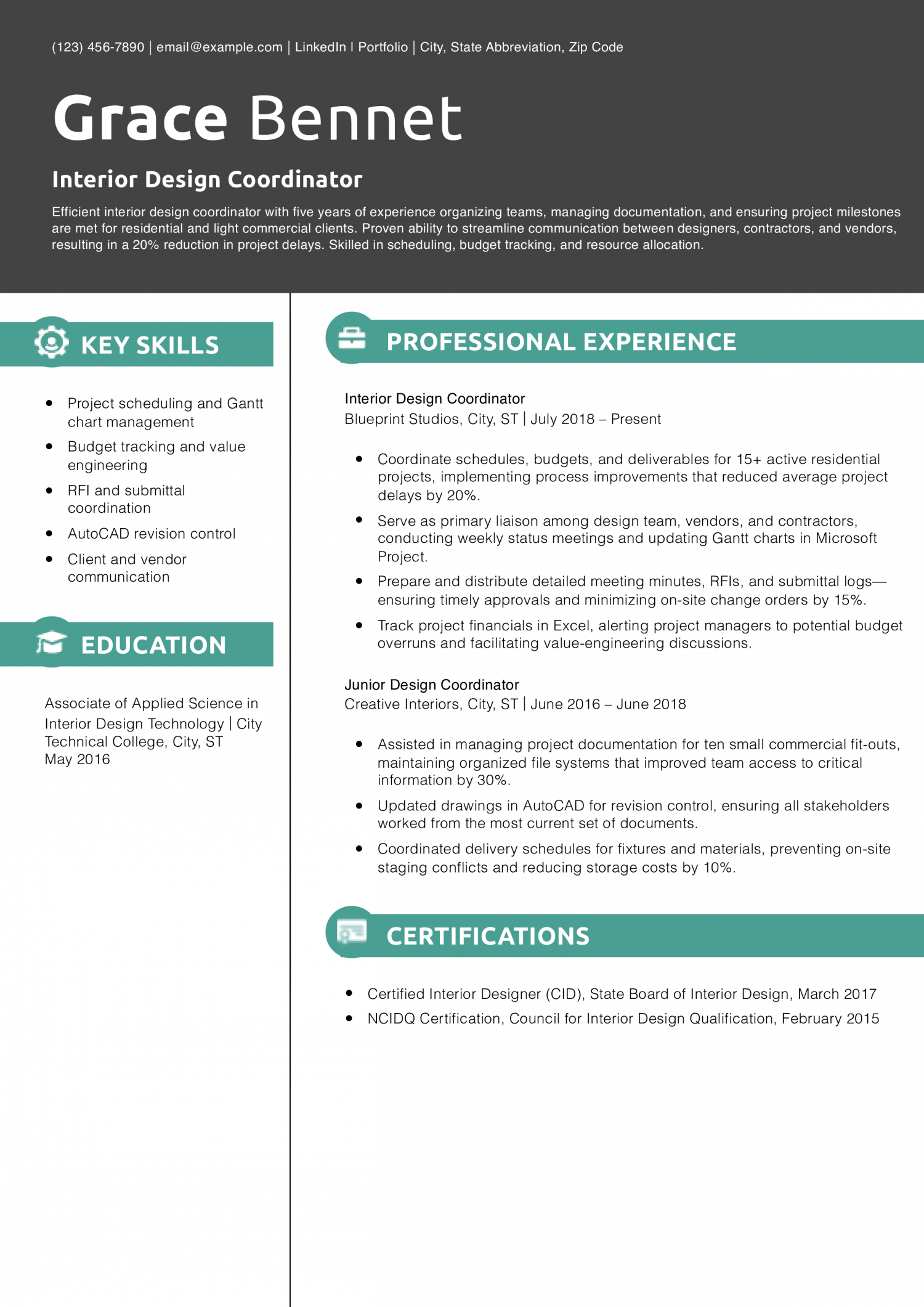
Why This Resume Is a Great Example
This resume highlights the coordinator’s role in preventing project delays and budget issues, using percentages to quantify process improvements. Emphasizing documentation management and communication skills shows reliability in keeping complex projects on track.
Key Tips
When you focus on coordination, quantify reductions in delays or cost savings from better scheduling. Metrics illustrate how your organizational skills translate to smoother project delivery. For advice on showcasing process improvements, see Work Experience on a Resume.
Junior Interior Designer Resume Example
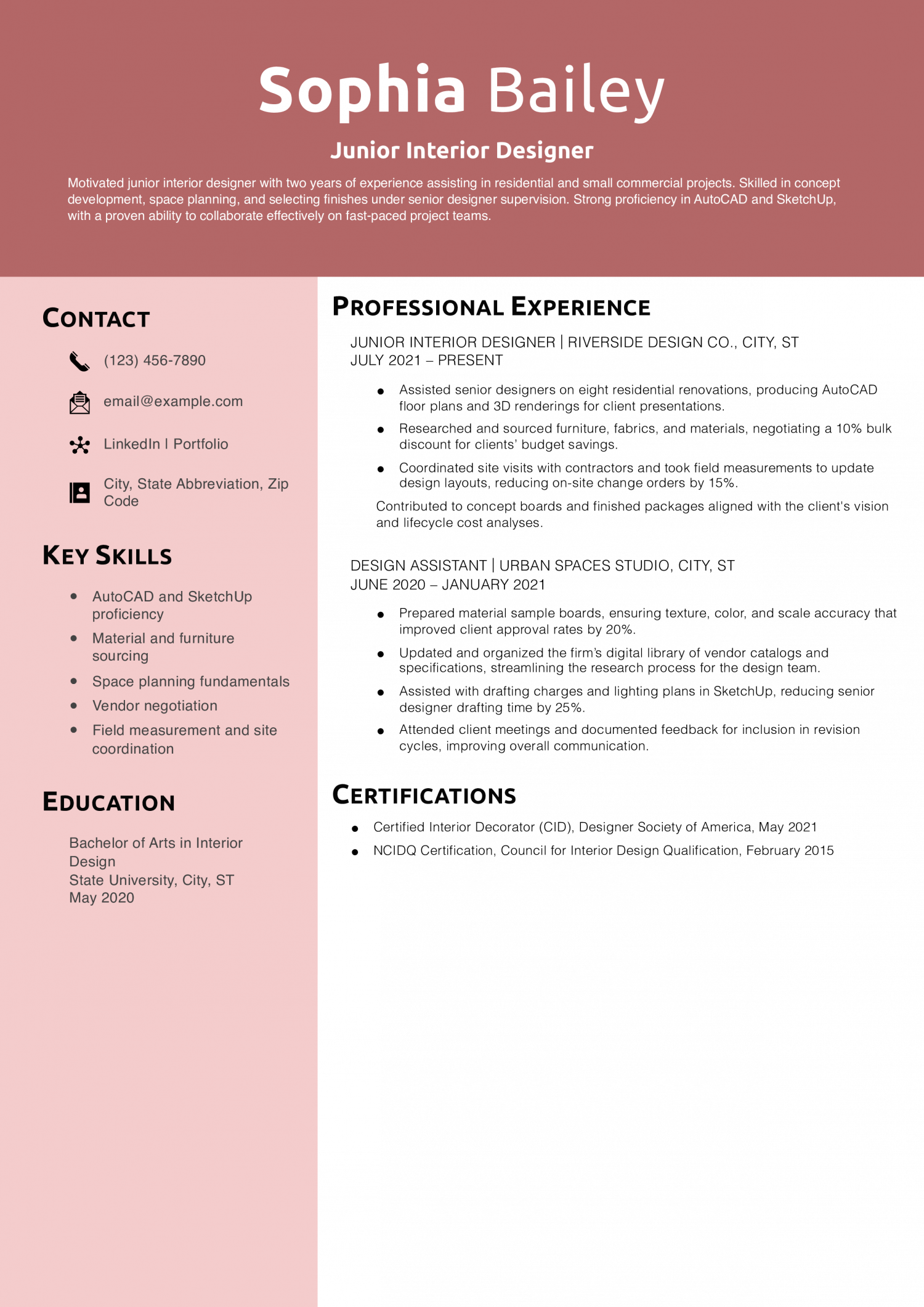
Why This Resume Is a Great Example
This resume emphasizes the candidate’s tangible contributions, like cost savings and reduced change orders, demonstrating real impact early in their career. Highlighting software proficiency and coordination skills shows readiness to take on more responsibility.
Key Tips
Include specific software tools you’re proficient in (e.g., AutoCAD, SketchUp) and quantify process improvements (e.g., time saved, cost reductions). For more on structuring your resume effectively, check out Best Resume Formats.
Interior Design Assistant Resume Example
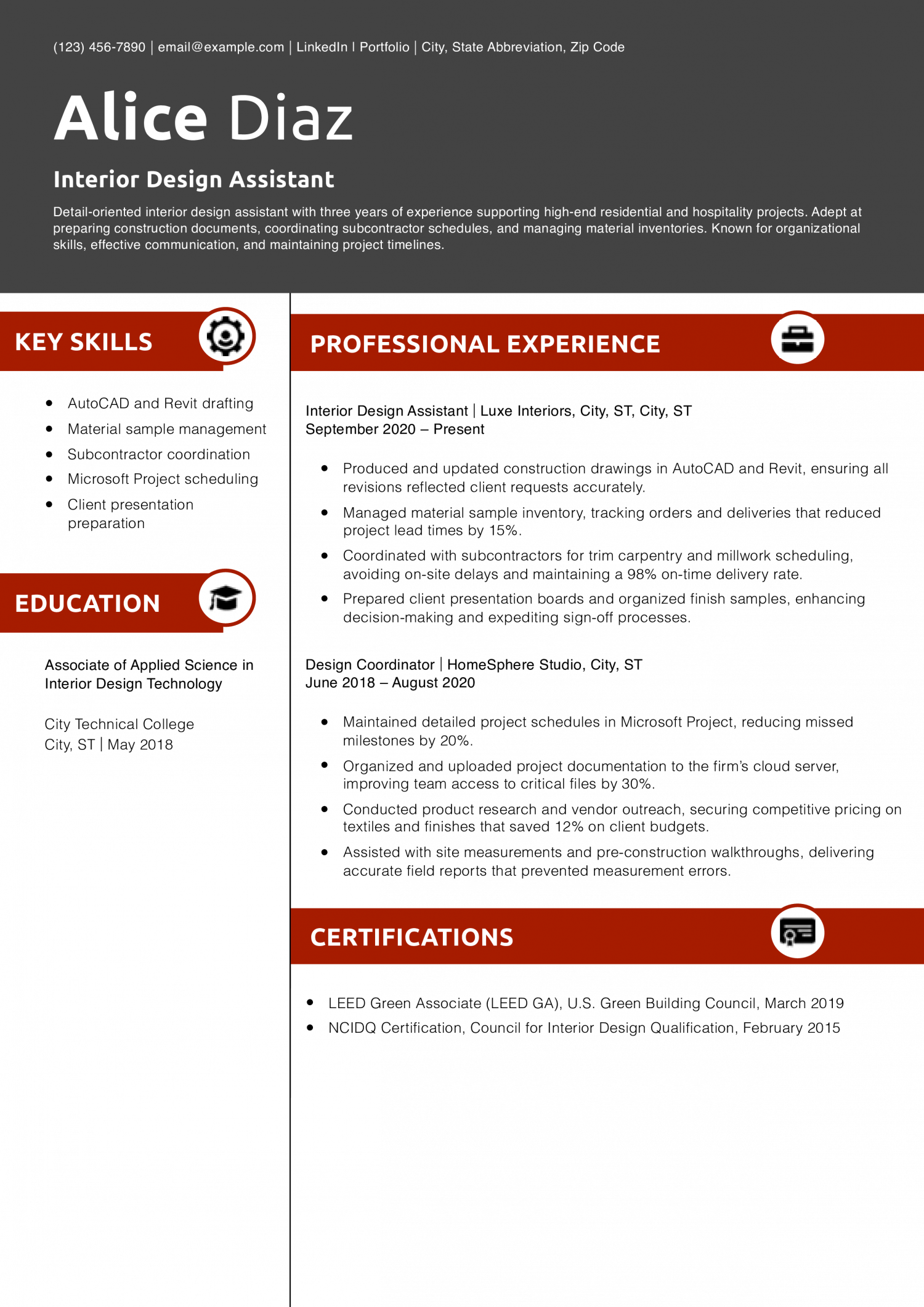
Why This Resume Is a Great Example
By quantifying reductions in lead times and cost savings, this resume demonstrates how the candidate’s coordination and organizational efforts directly benefit project efficiency and budgets. Highlighting software and scheduling tools underscores technical competency.
Key Tips
Quantify your impact on timelines and budgets (e.g., percent reduction in delays or cost savings) to show how supporting roles drive results. Learn more about optimizing your experience section at Work Experience on a Resume.
Residential Interior Designer Resume Example
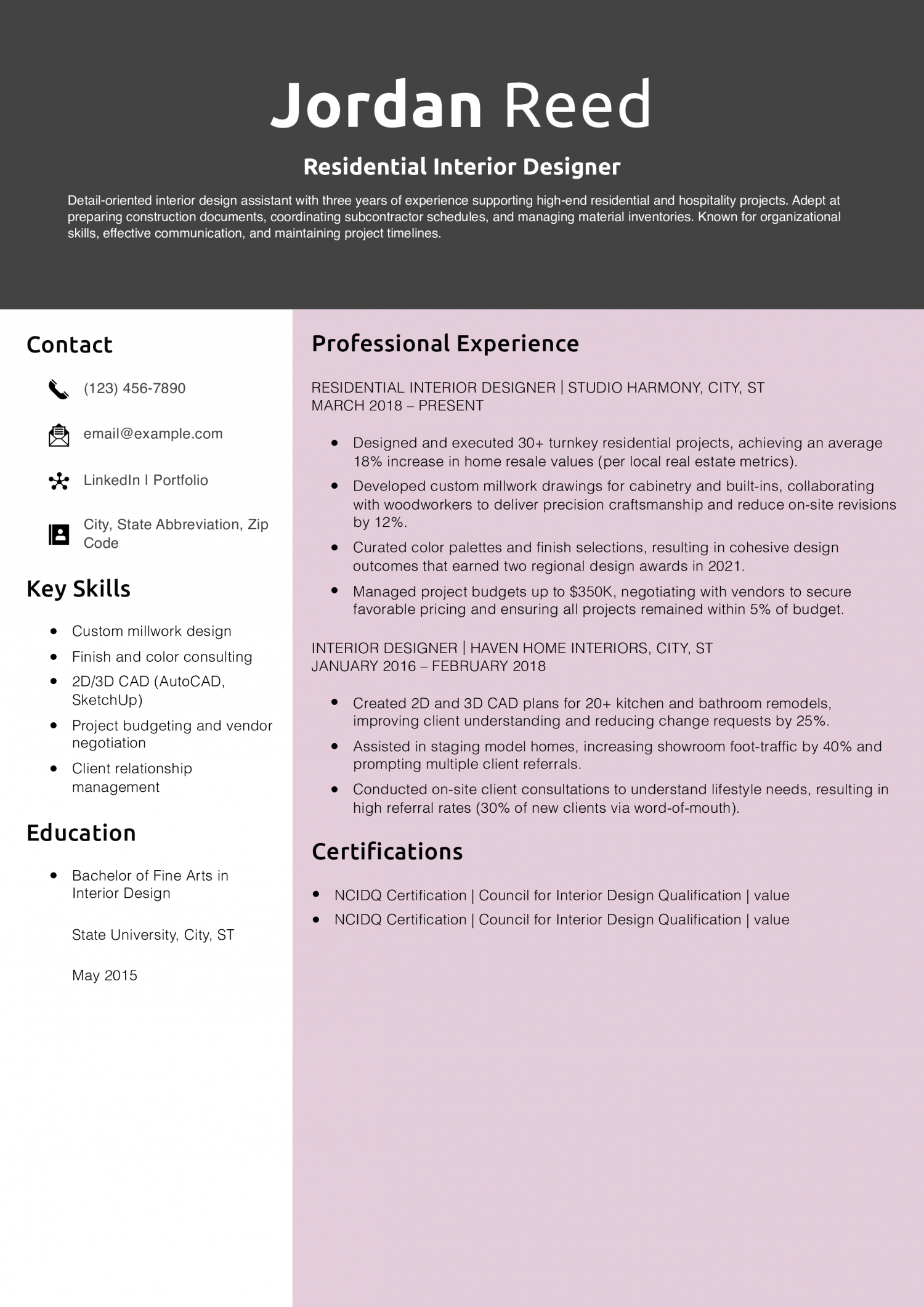
Why This Resume Is a Great Example
Quantifying resale value improvements and change order reductions connects design decisions to tangible client benefits. Project budget accuracy and award recognition demonstrate both financial stewardship and design excellence.
Key Tips
Tie your design work to financial metrics (e.g., resale value increases or cost containment) to illustrate ROI for clients. For insights on crafting a results-driven profile, see How to Write a Resume Summary.
Commercial Interior Designer Resume Example
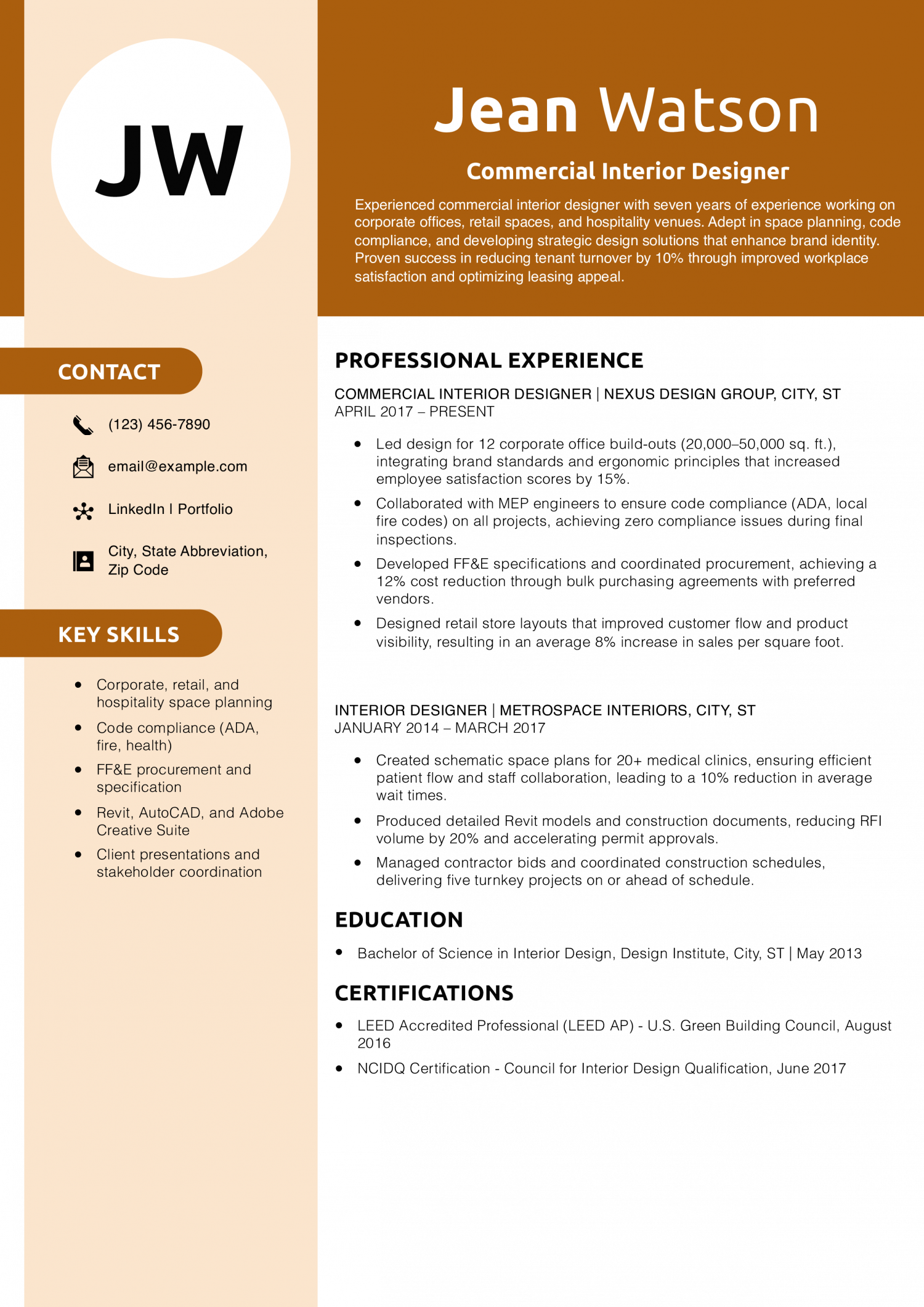
Why This Resume Is a Great Example
This resume clearly connects design choices to improved metrics like employee satisfaction, sales per square foot, and reduced wait times, demonstrating the candidate’s ability to solve business challenges through design.
Key Tips
Highlight compliance achievements and measurable business impacts (e.g., increased sales or satisfaction). For guidance on showcasing industry-specific skills, see Technical Skills in an IT Resume.
Hospitality Interior Designer Resume Example
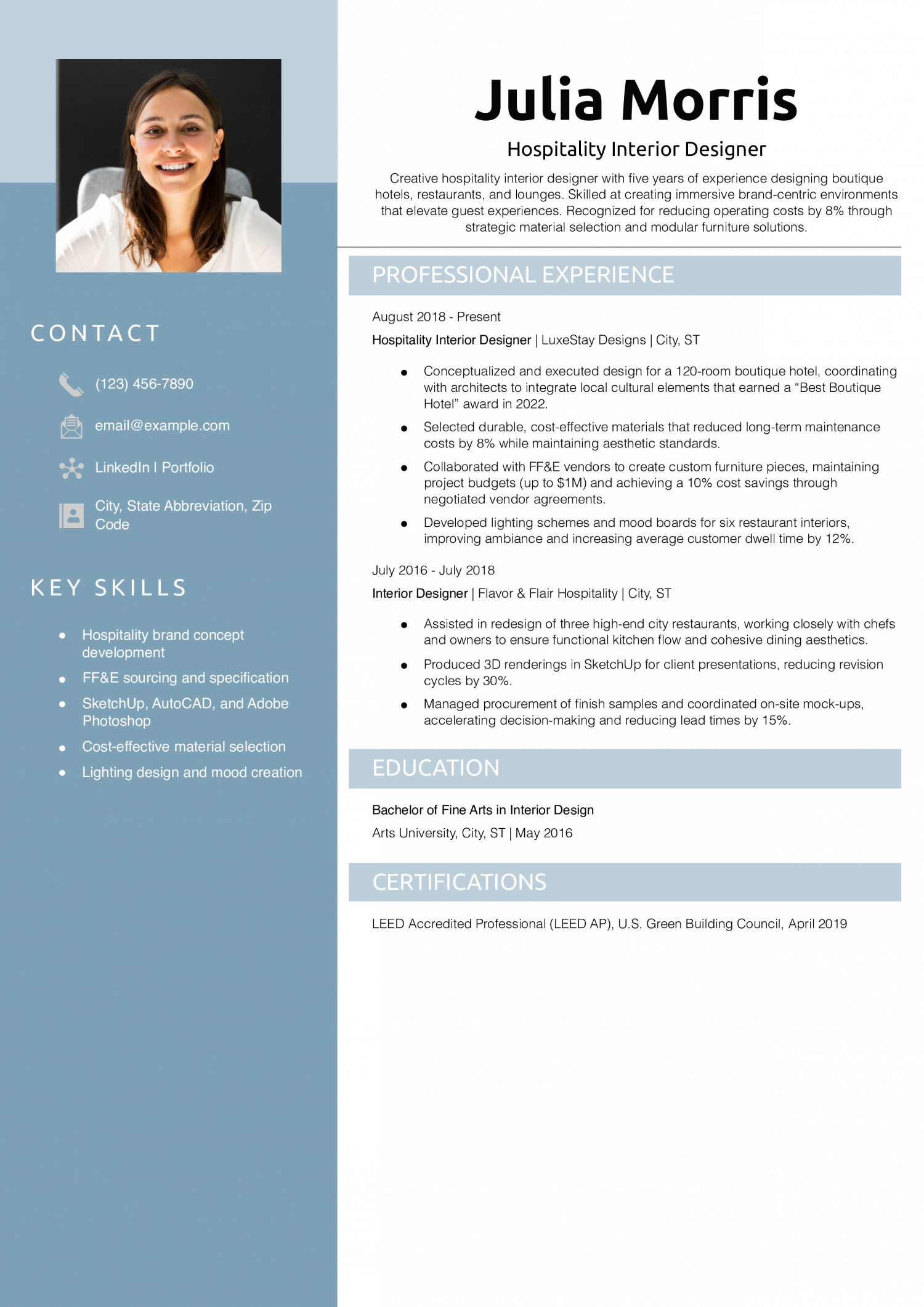
Why This Resume Is a Great Example
Quantifying cost savings and award recognition positions the candidate as both creative and fiscally responsible. Demonstrating reduced revision cycles and lead times signals strong project-management skills.
Key Tips
Specify awards, cost-saving percentages, and time reductions to underscore both creative and operational strengths. For more on presenting design outcomes, see Resume Key Skills.
Retail Interior Designer Resume Example

Why This Resume Is a Great Example
Linking design changes to transaction value increases and cost reductions highlights ROI. Scalable template development demonstrates forward-thinking and efficiency, which are key in retail rollouts.
Key Tips
Quantify metrics such as transaction value improvements and cost savings to highlight your design’s business impact. Learn more about showcasing skills and results at Best Resume Formats.
Sustainable Interior Designer Resume Example
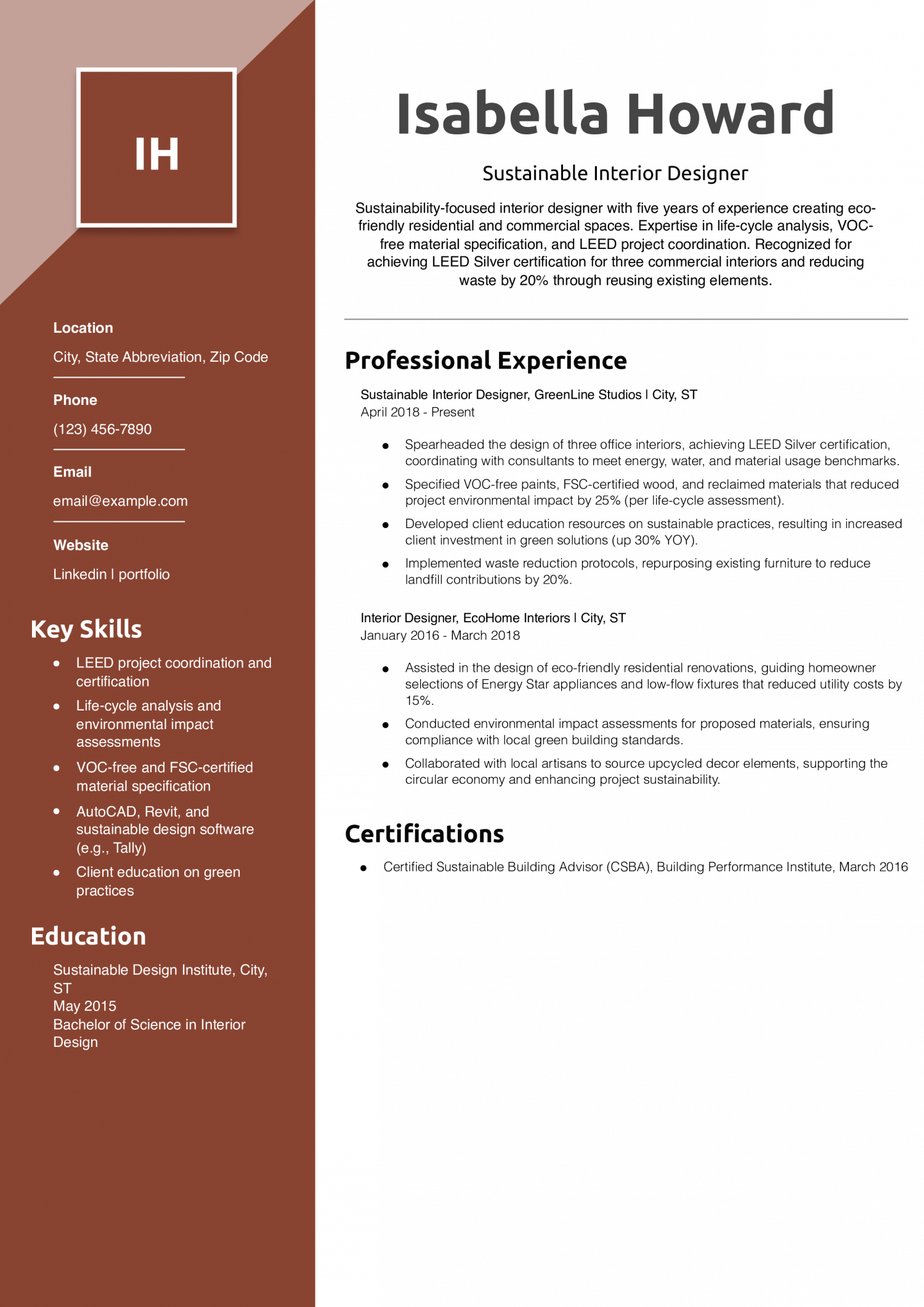
Why This Resume Is a Great Example
Linking LEED certifications and percentage waste reductions illustrates real environmental impact. Detailing client education initiatives shows leadership in driving sustainable change.
Key Tips
Tie your sustainability work to certifications earned and quantifiable waste or cost reductions. Highlight your ability to guide clients toward green solutions. For more on structuring your achievements, visit How to List Skills on a Resume.
Kitchen & Bath Designer Resume Example
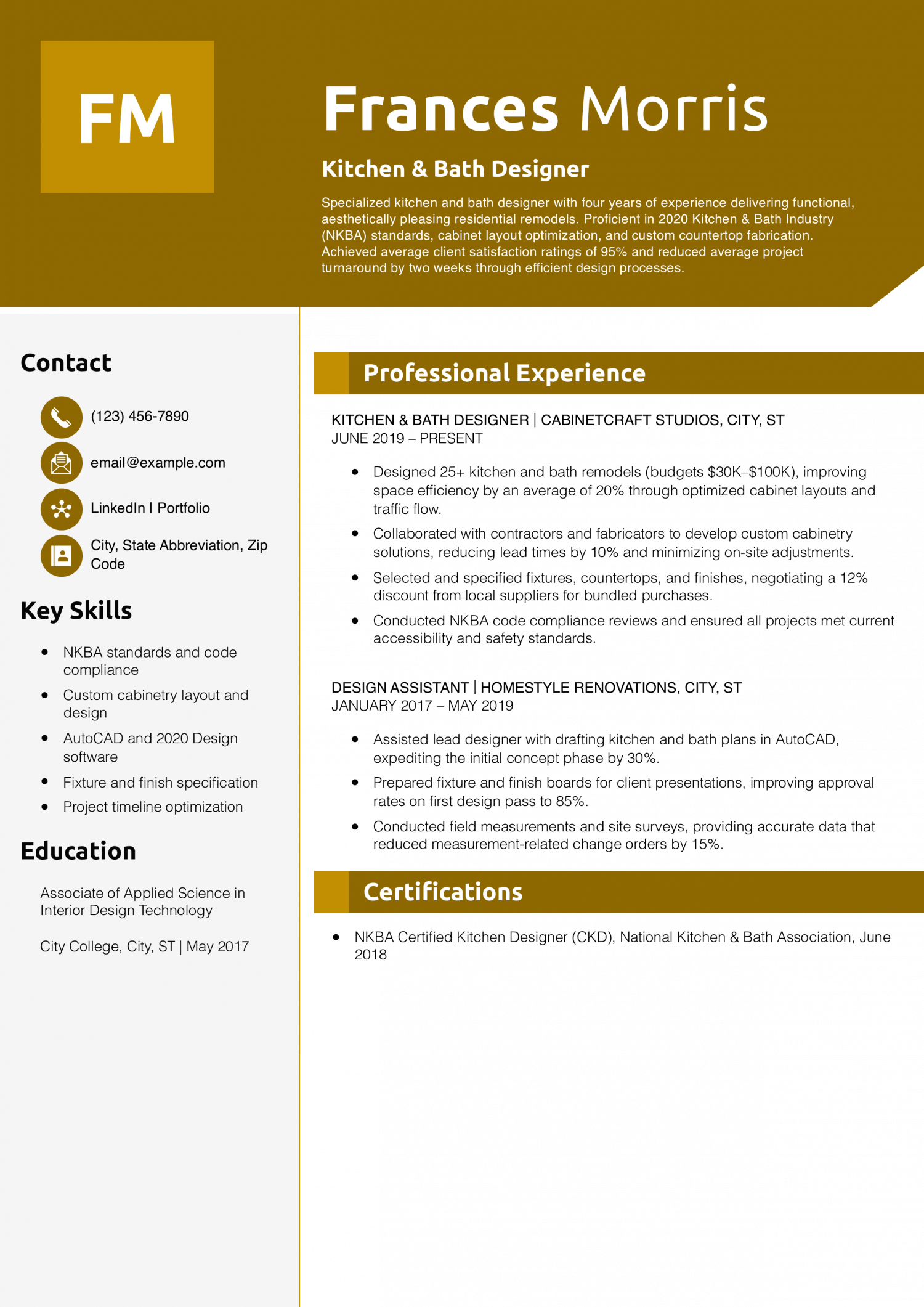
Why This Resume Is a Great Example
By quantifying layout efficiency gains and approval rates, this resume links technical design choices to improved client outcomes. Mentioning NKBA compliance highlights specialized industry expertise.
Key Tips
Include industry-specific certifications (e.g., CKD) and quantify improvements in space efficiency or project timelines. For more on highlighting specialized skills, see Resume Keywords.
Commercial Lighting Designer Resume Example
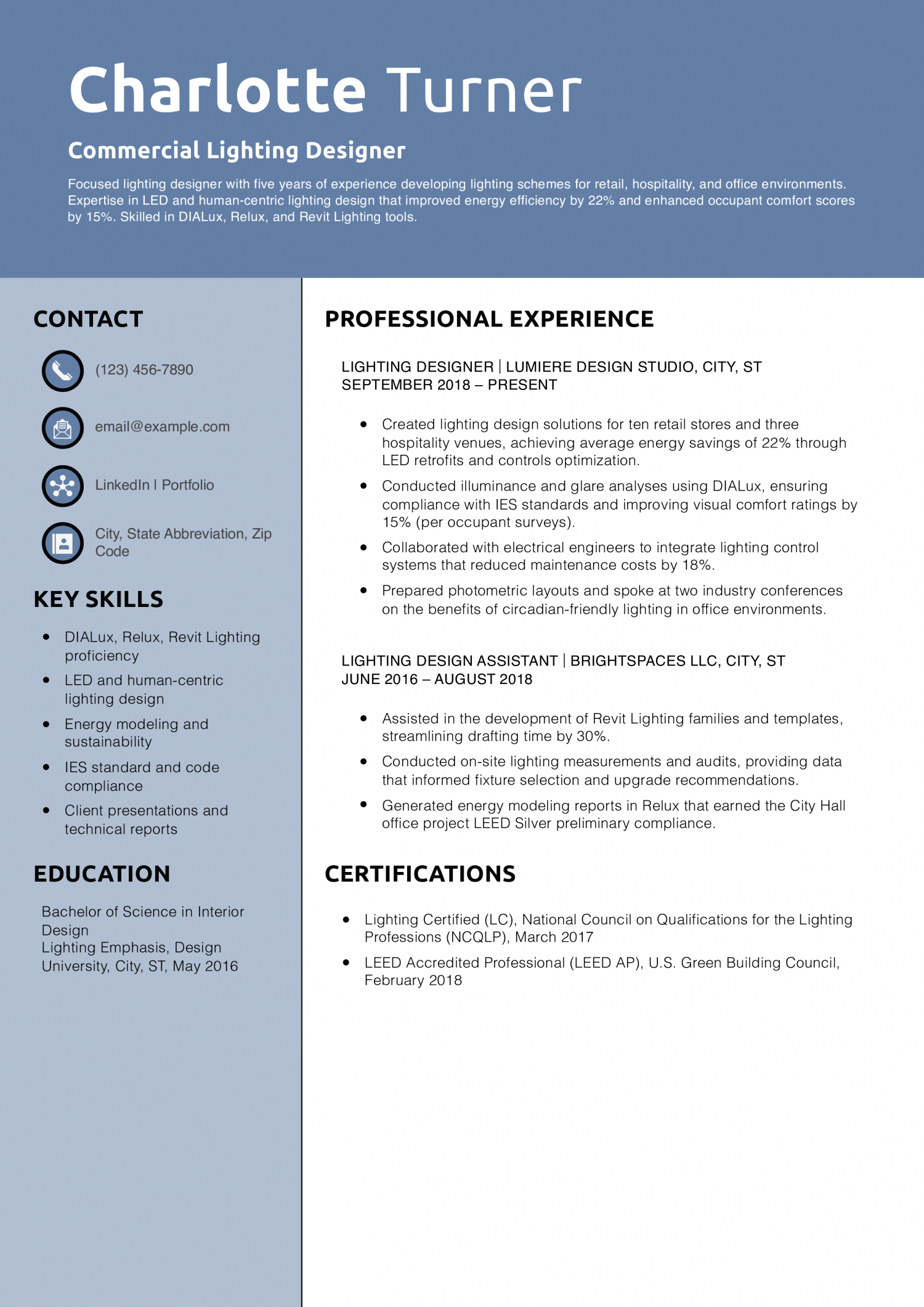
Why This Resume Is a Great Example
Quantifying energy savings and comfort improvements demonstrates direct value delivered through lighting design. Mentioning industry certifications and speaking engagements underscores thought leadership and technical expertise.
Key Tips
Tie your technical design work to energy and comfort metrics to highlight sustainability and occupant well-being. For guidance on specifying software skills, see How to List Skills on a Resume.
Healthcare Interior Designer Resume Example
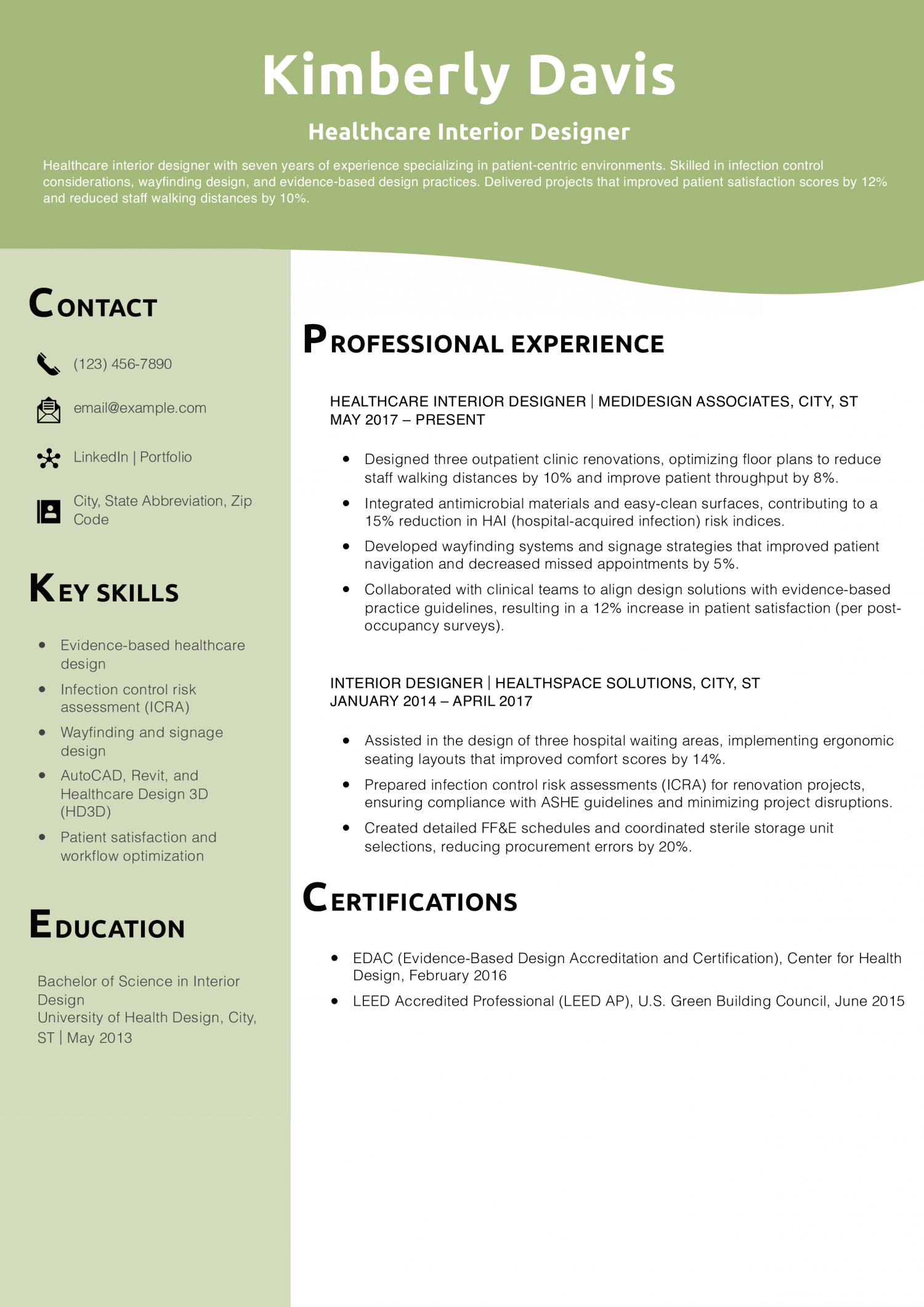
Why This Resume Is a Great Example
Highlighting patient satisfaction improvements and infection control metrics connects design expertise to real healthcare outcomes. Mention of evidence-based practices and certifications underscores specialized knowledge.
Key Tips
Quantify patient and staff workflow improvements and reference industry guidelines (e.g., ICRA). To learn more about presenting niche skills, visit Hard Skills for Resumes.
Education Facility Interior Designer Resume Example
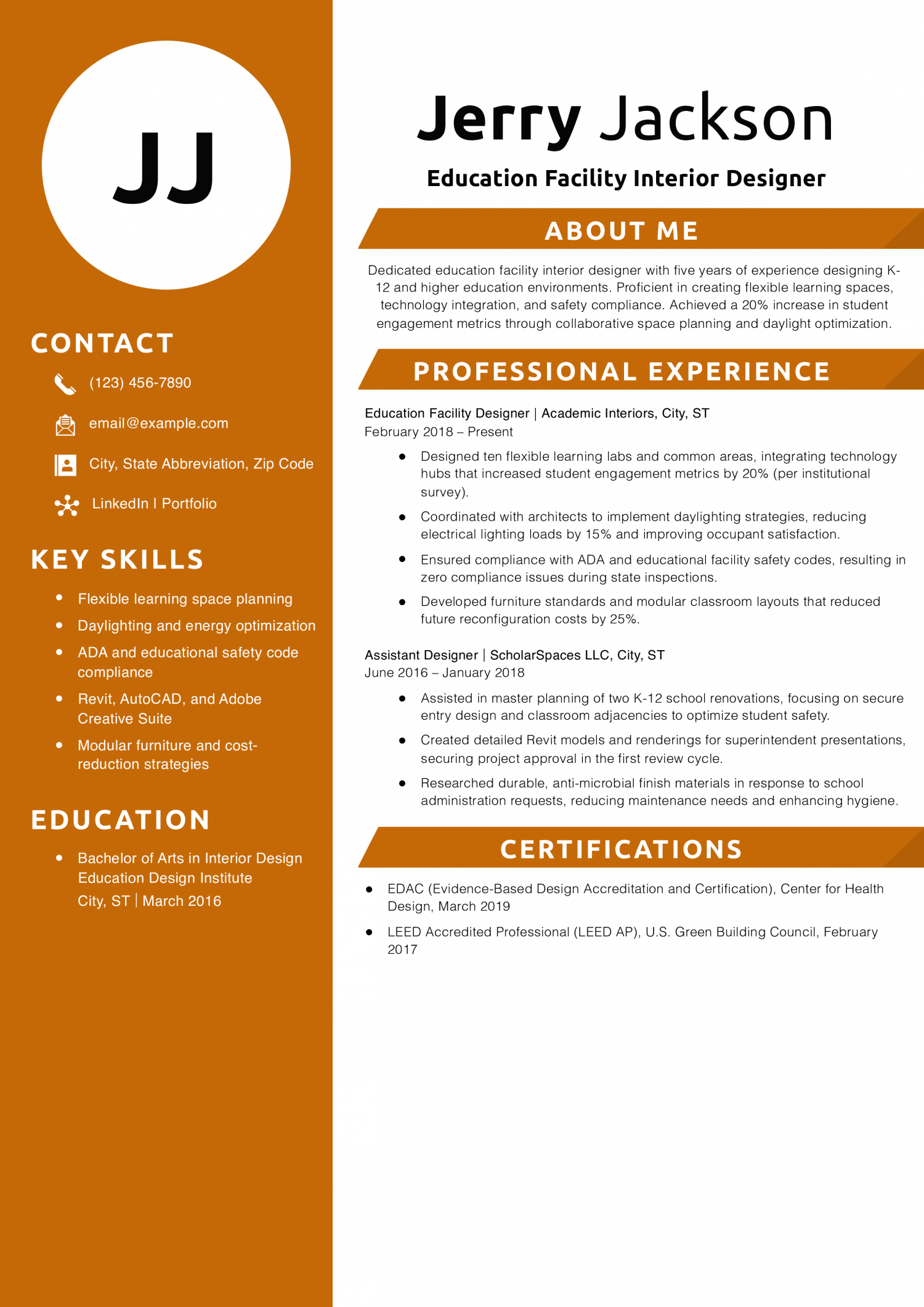
Why This Resume Is a Great Example
Quantifying engagement and energy savings demonstrates how design choices influence both learning outcomes and operational costs. Emphasizing code compliance shows attention to safety and regulatory detail.
Key Tips
Include specific improvements (e.g., energy savings, engagement increases) to illustrate the impact of your design. For more on quantifying design results, see Resume Action Words.
Freelance Interior Designer Resume Example
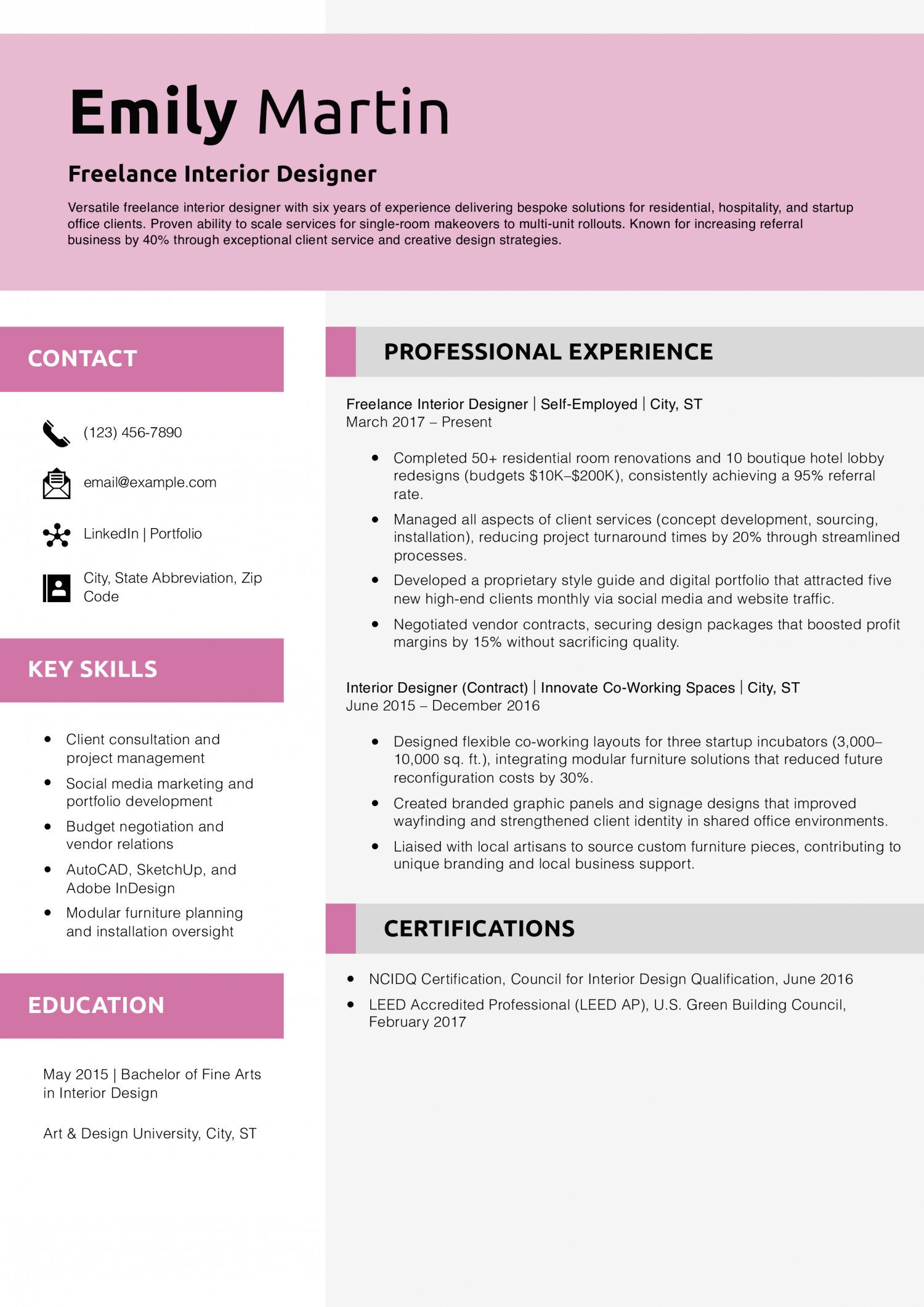
Why This Resume Is a Great Example
The emphasis on referral rates and profit-margin improvements highlights how freelance design translates directly into business growth. Including social media portfolio development underscores modern marketing savvy.
Key Tips
Highlight your referral rate and profit margin impacts to demonstrate business acumen. For more on presenting freelance experience, visit How to List Your Education on a Resume.
Interior Design Consultant Resume Example
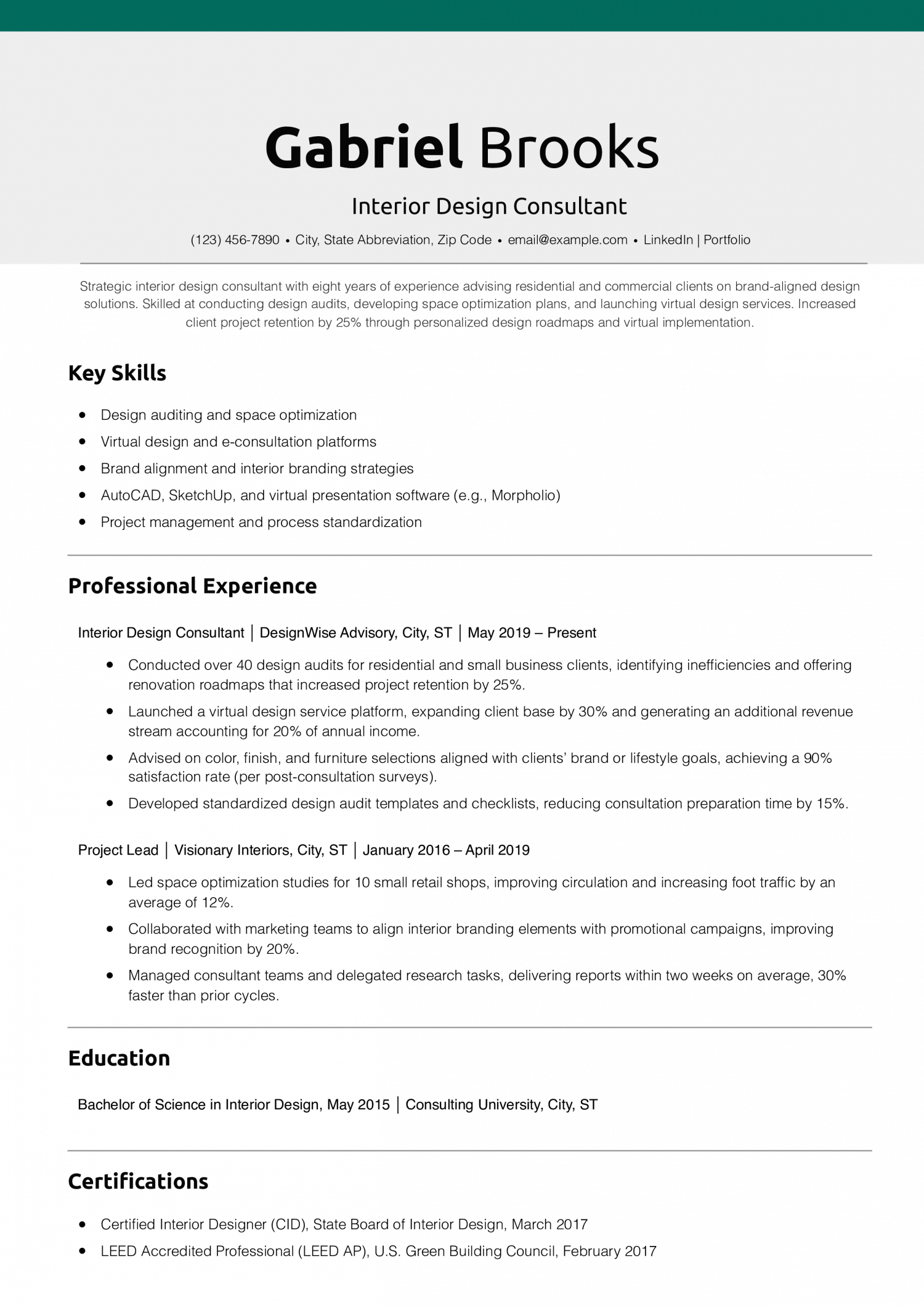
Why This Resume Is a Great Example
Quantifying increased client retention and revenue from virtual services demonstrates business development skills. The use of audit templates and faster delivery times underscores process efficiency and leadership.
Key Tips
Demonstrate how your consultation services translate into client and revenue growth. For advice on presenting your skills, see How to List Skills on a Resume.
Interior Design Project Manager Resume Example
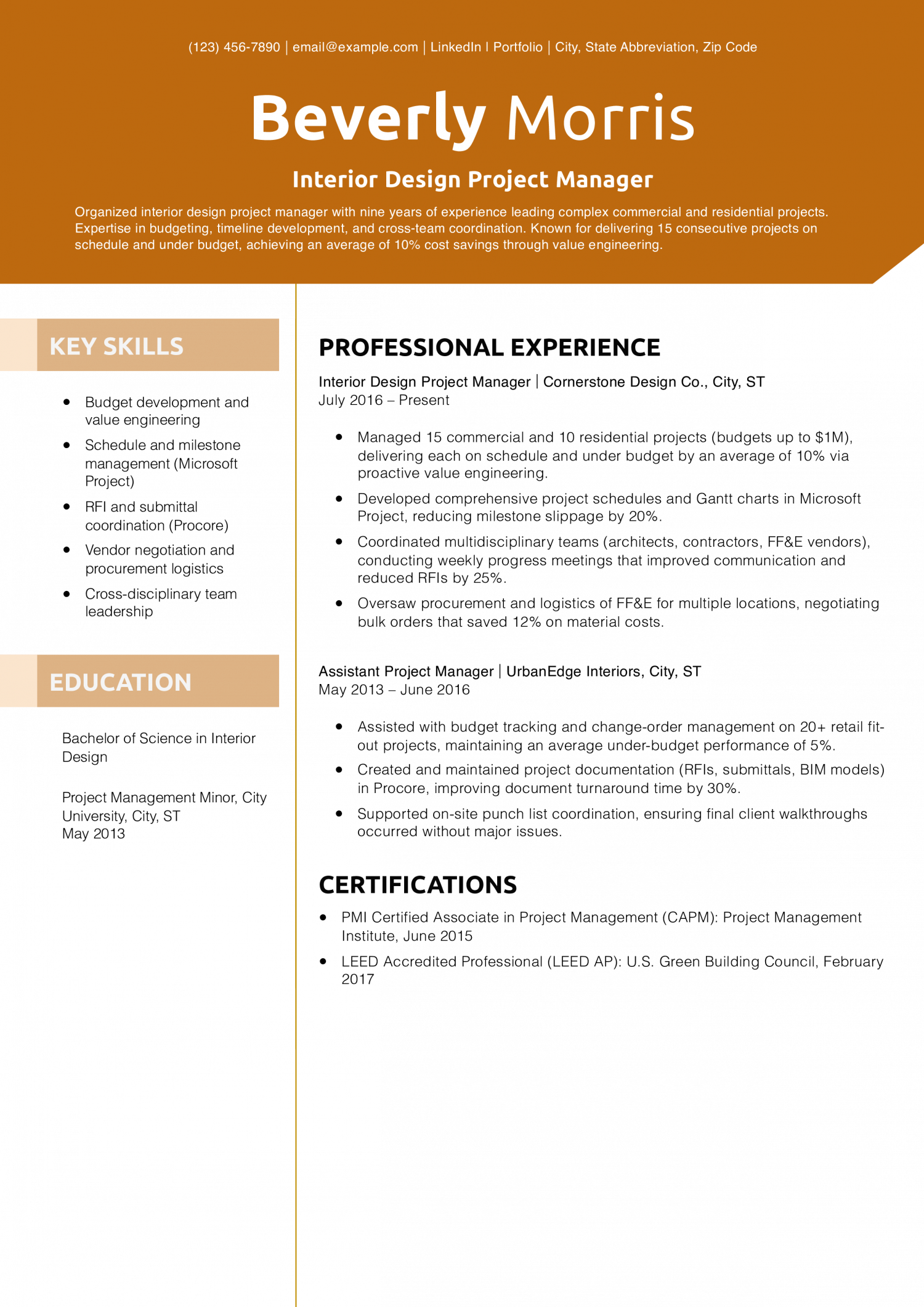
Why This Resume Is a Great Example
Quantifying under-budget performance and reduced RFIs highlights the candidate’s efficiency and proactive leadership. Mentioning specific tools (Procore, MS Project) demonstrates technical fluency in project management.
Key Tips
Use specific project management tools and track budget or timeline improvements to showcase your organizational strengths. Learn more at Resume Keywords.
Interior Design Student Resume Example
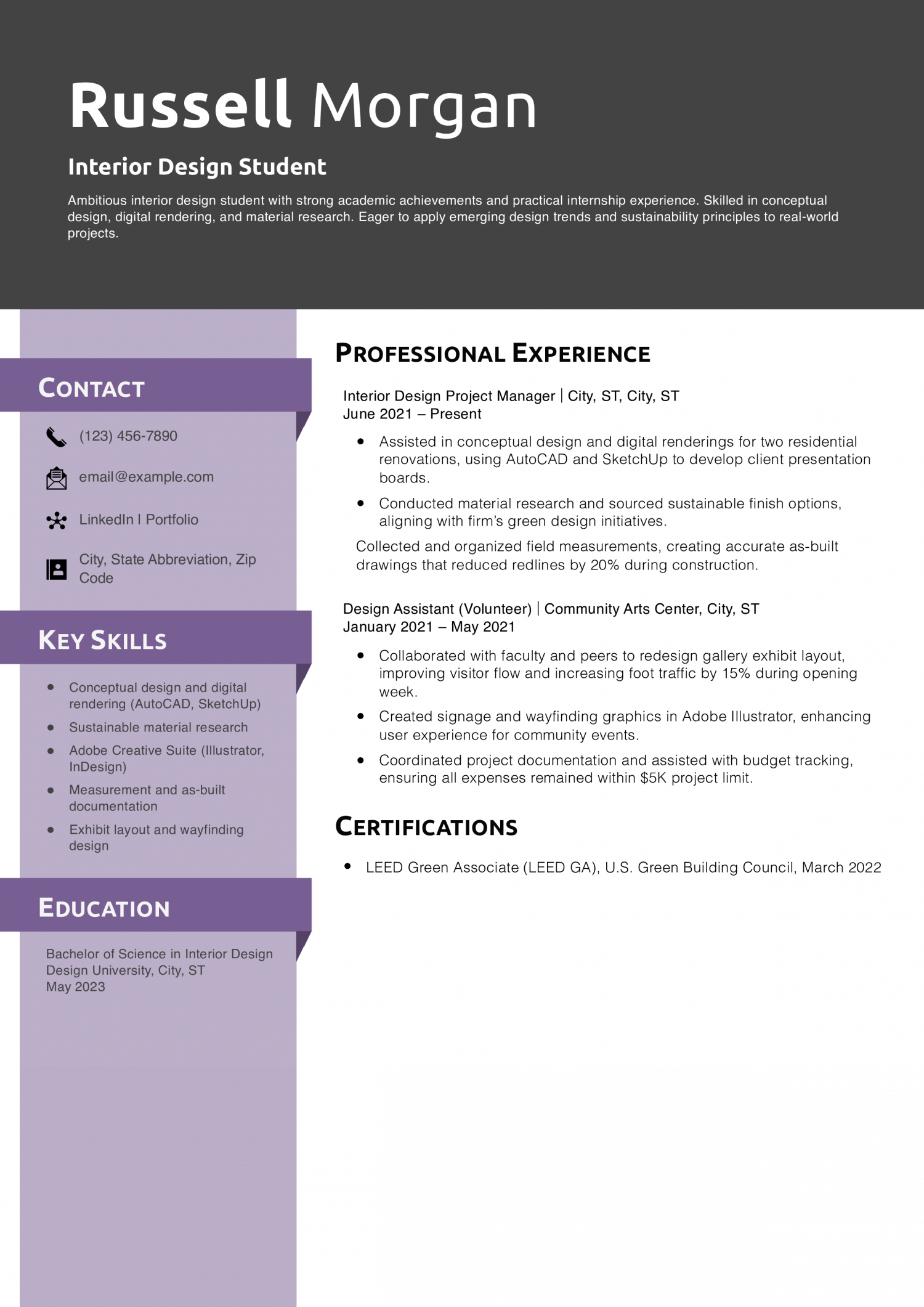
Why This Resume Is a Great Example
Highlighting sustainability research and measurable improvements (e.g., reduced redlines, increased foot traffic) shows practical impact even as a student. Presenting a strong GPA and certifications underscores a commitment to excellence.
Key Tips
When you have limited professional experience, focus on measurable academic and internship achievements. Use metrics (e.g., foot traffic, budget control) to illustrate results. For more student resume inspiration, visit How a Resume Should Look for a College Student.
Virtual Interior Designer Resume Example
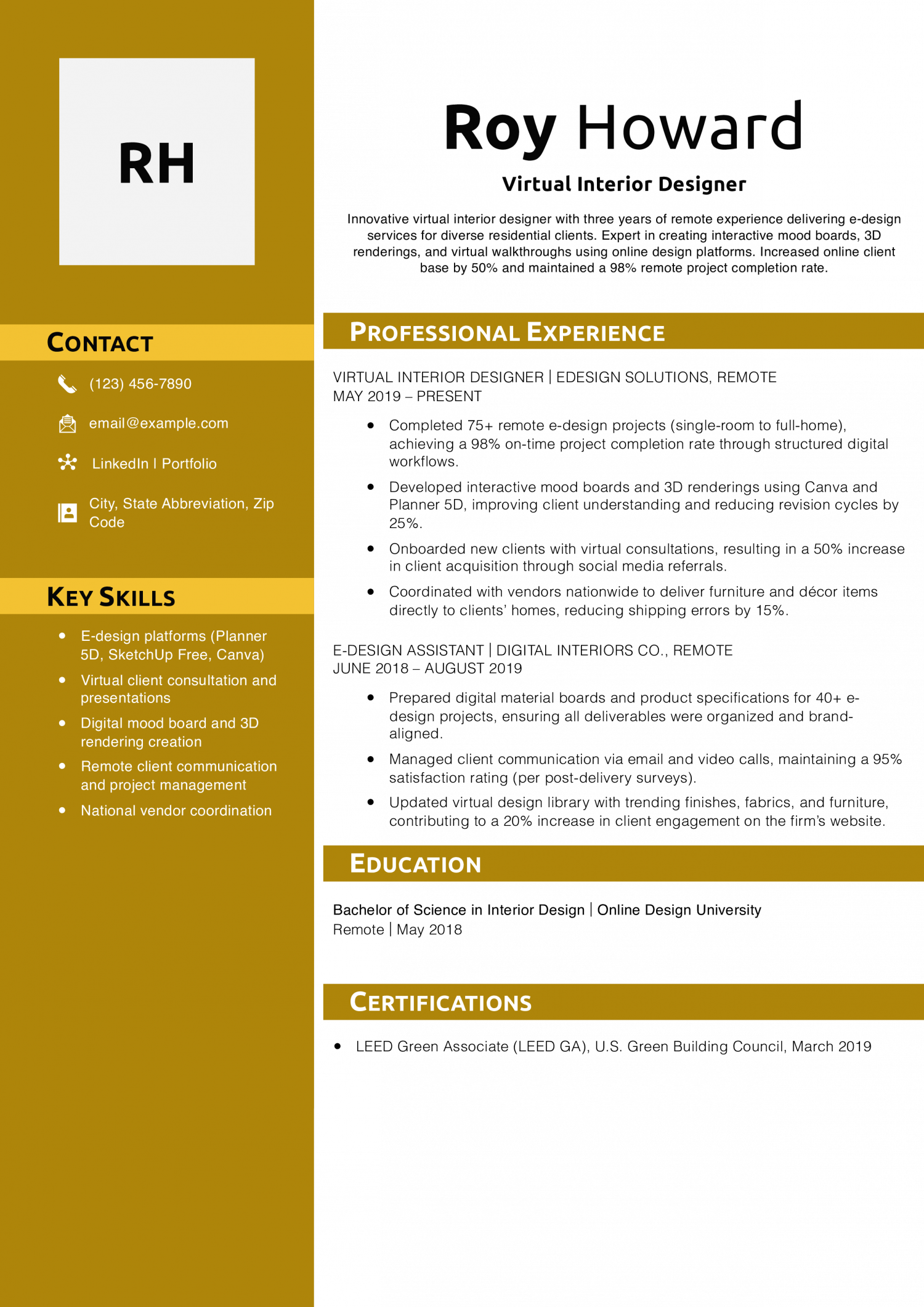
Why This Resume Is a Great Example
Quantifying remote project completions and client acquisition growth demonstrates adaptability and digital proficiency. Emphasizing high satisfaction ratings underscores strong virtual communication skills.
Key Tips
Highlight your remote and digital design proficiencies (e.g., specific software tools) and quantify client satisfaction or acquisition metrics. For more on presenting e-design skills, see How to Add a Resume to LinkedIn.
Interior Design Project Coordinator Resume Example
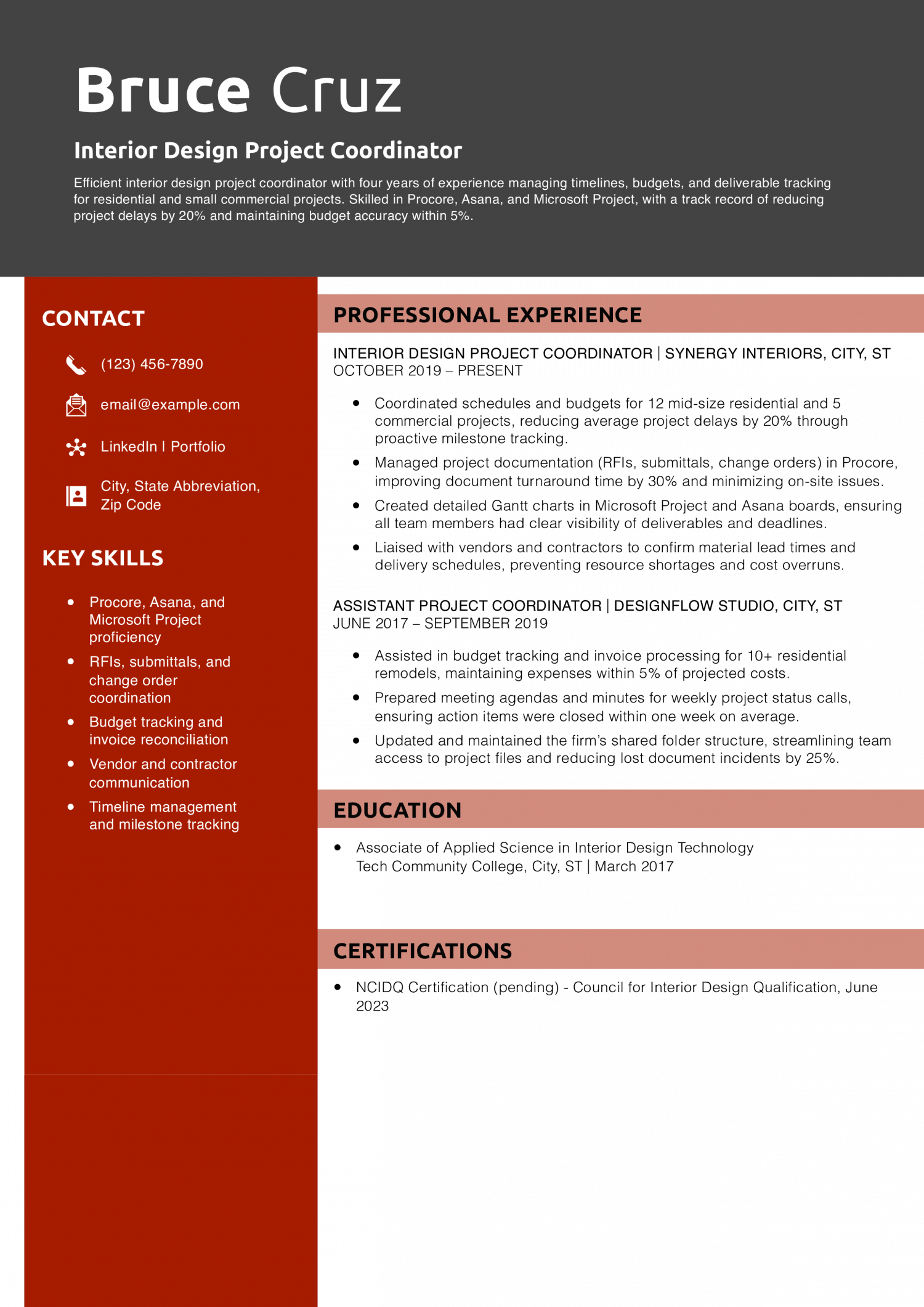
Why This Resume Is a Great Example
Highlighting quantified reductions in delays and budget variances underscores strong coordination and organizational skills. Referencing specific project management tools demonstrates technical fluency.
Key Tips
Specify the project software you use and quantify process improvements (e.g., percent reduction in delays). For more on emphasizing coordination skills, see Work Experience on a Resume.
Interior Design Text-Only Resume Examples and Templates
How To Write an Interior Design Resume Example
Interior design resumes should showcase the key attributes needed to successfully meet client needs. Highlight your ability to think creatively about maximizing a particular space, your specialization in a particular type of design (such as residential vs. commercial), and your academic background in design. Use the following template for your interior design resume:
- Contact information
- Profile
- Key skills
- Professional experience
- Education and certifications
1. Share your contact information
All resumes must include the most current contact information so that prospective employers can reach out. Include your full name, phone number, email address, and city/state, as well as a link to your online professional profile and website (if applicable).
Example
Your Name
(123) 456-7890
[email protected]
City, State Abbreviation Zip Code
LinkedIn | Portfolio
2. Write a brief summary of your interior design qualifications
Take the first section of your resume to introduce yourself and share a quick summary of your qualifications and professional accomplishments. It should be about two to three sentences long. You can mention your specializations, such as if you design office spaces versus private homes, and include any relevant certifications or well-known clients you’ve worked with. The goal is to engage the reader and capture their attention.
Senior-Level Profile Example
Highly skilled senior interior designer with several years of experience and a strong leadership background, specializing in the supervision and mentorship of design teams, complex project management, and client relationship cultivation. Proven expertise in advanced designing, space planning, meeting building codes and regulations, and using design software for compelling presentations. A track record of completing large-scale design projects whilst managing key client relationships, resulting in significant company revenue growth.
Entry-Level Profile Example
A motivated interior designer with a bachelor’s degree in interior design. Developed skills as a junior interior designer and design intern, practicing solid design concepts, material fetching, and client relationship management skills. Certified Interior Decorator known for keeping up-to-date with the latest interior design trends and demonstrating excellent space planning and project management competence.
3. Outline your interior design experience in a compelling list
If you look at professional resume templates, you’ll notice the professional history is the heart of the document. After listing all of the pertinent details about the job (company name, location, start and end dates), create three to five dynamic bullet points that spotlight your most impressive interior design accomplishments. At the same time, demonstrate you meet the qualifications for the job you’re seeking.
Senior-Level Professional Experience Example
Senior Interior Designer, Warner Bros Entertainment Inc., Burbank, CA | August 2015 – present
- Supervised and mentored a team of six junior interior designers, fostering an environment of creativity and growth
- Developed innovative design concepts for high-value projects such as film sets
- Managed client relations, securing four new large-scale projects that resulted in a 20% increase in company revenue
Lead Interior Designer, Adobe Systems, San Francisco, CA | June 2012 – July 2015
- Led complex interior design projects from conceptualization to completion, meeting deadlines and staying within budget
- Performed space planning for commercial buildings, adhering to building codes and regulations
- Used advanced interior design software to create visually compelling design presentations, enhancing client satisfaction rate by 40% over a six-month period
Entry-Level Professional Experience Example
Junior Interior Designer, Adobe Systems, San Francisco, CA | June 2021 – present
- Develop design concepts using Computer-Aided Design (CAD) software, resulting in efficient and visually appealing digital design plans that meet client needs
- Play an essential role in material and furnishing selection based on the latest interior design trends and clients’ budgets
- Manage relationships with clients effectively, including communicating project status, resolving queries, and ensuring designs align with client expectations
Design Intern, Time Warner Inc., New York, NY | May 2020 – June 2021
- Assisted with various interior design projects, gaining extensive exposure to concept development and execution using CAD software for different clients
- Supported senior designers in the selection of materials, colors, and furnishings according to the latest interior design trends
- Gained experience in client relationship management under the guidance of senior designers by resolving minor client issues and updates related to project status
Resume writer’s tip: Quantify your experience
Whenever possible, incorporate data to support the notion that you’re good at your job. Employers like to quantify the value you can bring to their organization. With interior design, it might mean sharing your customer satisfaction scores, describing how you came in under budget, or how you used a space more efficiently.
Here’s an example of how it could look on your interior designer resume:
Do
- “Helped design team with space planning and implementation, enhancing the usability and ergonomics of numerous work areas and improving space utilization by up to 40%”
Don’t
- “Assisted in space planning and enhancing ergonomics”
Resume writer’s tip: Tailor your resume for each application
Although it’s good to have a master resume, each time you send it out, consider making some minor updates so that it aligns better with that particular company’s needs. This can help increase your chances of getting called for an interview, especially given that interior design jobs are only projected to increase by 4% through 2032. For instance, if a job posting mentions a particular design or architectural style that you happen to have experience with, add that.
What if you don’t have experience?
For interior designers who may be fresh out of school, even if you have limited work in the field, you can discuss other relevant experiences. For example, you can list any related coursework, academic projects, or internships that have prepared you. Even unrelated past jobs might have transferable skills like strong communication, creative solution-finding, or client relations.
4. Add interior design education and certifications
Interior designers usually pursue degree programs to help them hone their craft, so be sure to list all of the relevant schooling you’ve completed. Certifications from professional associations like the Interior Design Society can also demonstrate your skills. For each degree or professional certificate, list the name of the school, the degree/certification name, and the date completed.
Education
Template:
[Degree Name]
[School Name], [City, State Abbreviation] | [Graduation Year]
Example:
Bachelor of Fine Arts in Interior Design
The New School, Parsons School of Design, New York, NY, 2018
Certifications
Template:
[Certification Name], [Awarding Organization], [Completion Year]
Example:
- Certified Interior Decorator (CID), Interior Design Society, 2019
5. List key interior design skills and proficiencies
Interior designers who want their resumes to shine should consider listing their key skills as bullet points. This easy way to make your competencies stand out also helps your resume make it through ATS filters that may be looking for keywords.
Share both the hard and soft skills most relevant to the jobs you’re seeking. For example, say you have done interior design work for a health care facility and worked with private clients in the past. You may want to highlight your commercial experience more if you’re aiming for a job designing an office space.
Here are some possible skills you can include:
| Key Skills and Proficiencies | |
|---|---|
| Adobe Creative Suite | AutoCAD |
| Budgeting | Client relations |
| Communications | Finding solutions |
| Project management | Residential designs |
| Space planning | Vendor collaboration |
Resume writer’s tip: Use specific action verbs
The professional experience section of your resume should be attention-grabbing rather than a long list of job duties. Using impactful action verbs can help tell the story of your past achievements. Here are some action verbs to consider using for your interior designer resume:
| Action Verbs | |
|---|---|
| Collaborated | Conceptualized |
| Created | Designed |
| Developed | Enhanced |
| Illustrated | Implemented |
| Presented | Sourced |
How To Pick the Best Interior Design Resume Template
When applying for interior design positions, select a resume template that looks professional and clean so that your skills and accomplishments are the focus. Though it can be tempting to include imagery, creative fonts, and colors, those elements can be distracting and are often not ATS-friendly.
Frequently Asked Questions: Interior Design Resume Examples and Advice
Interior design jobs are expected to grow as fast as the average occupation through 2032, according to the Bureau of Labor Statistics. To get ahead of the strong competitors vying for new opportunities, applying to roles that align well with your skills and goals is important. In some cases, putting the spotlight on specific attributes called out as significant in a job description can help get your resume through to the next step.
As with many professions, using a reverse-chronological resume format is probably the best option for interior designers. Recruiters are most familiar with that format, and it allows you to share your career story with the most recent accomplishments up at the top.
As with many professions, using a reverse-chronological resume format is probably the best option for interior designers. Recruiters are most familiar with that format, and it allows you to share your career story with the most recent accomplishments up at the top.
Include a cover letter with your resume
Writing a cover letter to send with your resume can give you a chance to explain what makes you an ideal fit for a particular organization.
Check Out Related Examples
Resume Templates offers HR approved resume templates to help you create a professional resume in minutes. Choose from several template options and even pre-populate a resume from your profile.


